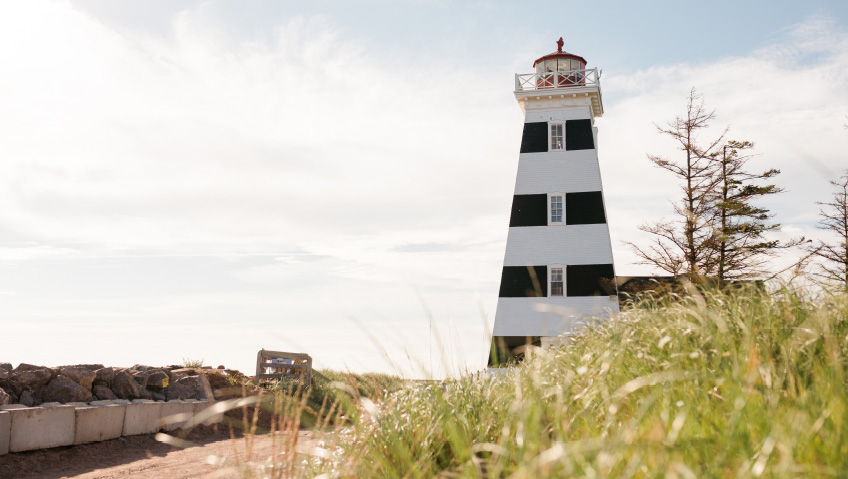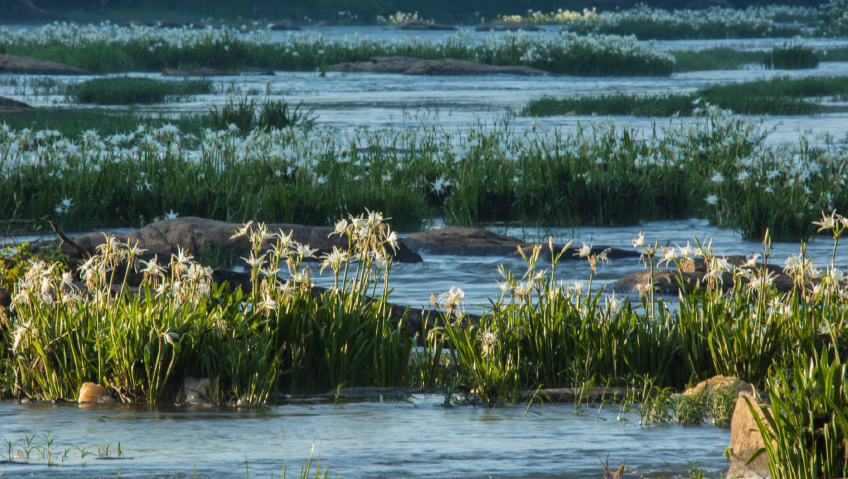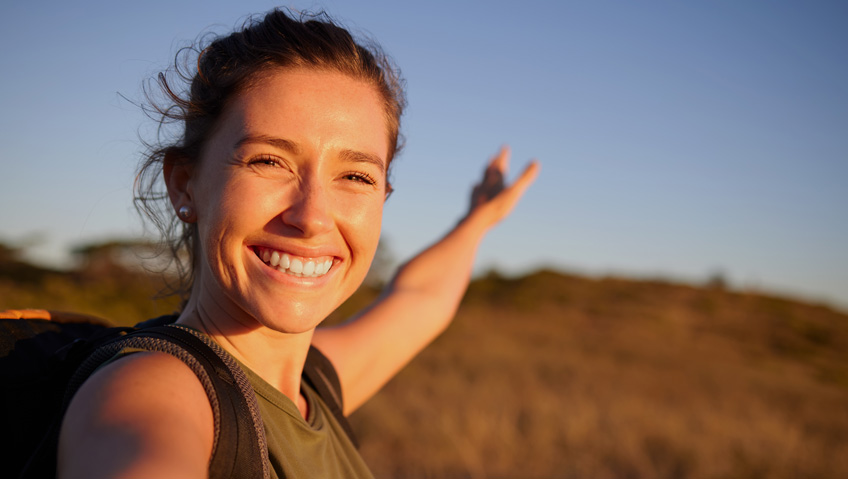When Mi’kmaq people greet a visitor with “Pjila’si,” they’re not only saying “Welcome,” they’re saying, “Come in and sit down!”
That’s because they truly want to invite non-Indigenous people into their community and share experiences, as Jamie Thomas, Director of Culture and Tourism for Lennox Island First Nation, tells us. “There seems to be a misconception among some non-Indigenous people who think they wouldn’t be allowed to come into a First Nations community, and that notion is something we are working to change, and something Amanda and I have talked about.”
We enjoy a wide-ranging conversation with Thomas, who in addition to her culture and tourism role, serves on the national board of the Indigenous Tourism Association of Canada and is the Business & Partnership Development Manager with the MCPEI – Skills Partnership Fund for the Lennox Island First Nation, and Amanda Barlow, Interim Executive Director for North Cape Coastal Tourism Area Partnership (NCCTAP), which is a member of the Tourism Association of Canada (TIAC) and partners with Lennox Island First Nation.
Working together
A recurrent theme in our conversation is the importance of working together. Barlow speaks about partnerships NCCTAP has formed with over 100 members who provide accommodation, experiences, restaurants, entertainment, and “anything to do with tourists coming to the western side of PEI; from Summerside on the Northumberland Strait to Lennox Island in Malpeque Bay—linked via a causeway—and to North Cape on the northwest tip.
“We welcome people from everywhere, from Souris on the east coast of the island, from anywhere in Canada, or from around the world, which includes international tourists arriving on cruise ships.”
The traditional tourist season opens on the Victoria Day weekend in May, with plenty of activities around the beautiful beaches on each side of the region. There is the Keep it Canadian Dinner Theatre, daily free entertainment, and an impressive concert series lined up at the Stompin’ Tom Centre, (named for the iconic singer, Stompin’ Tom Connors) in Skinner’s Pond.
There’s the Village Musicale Acadien in Abram Village, and a unique opportunity to learn about the province’s Indigenous people on Lennox Island.
There are also activities in the off-season. The Mill River Resort offers cross-country skiing, skating, and horse-drawn sleigh rides and has the capacity to host conferences. New this winter will be an ATV tourism product, the result of a partnership with the ATV Federation, which has connected existing trails.
And in October, the area will host five Fall Flavours events, part of an island-wide culinary festival which includes 26 events. One large event, featuring oysters and the best that local craft breweries and live entertainment have to offer, has drawn up to 300 people to Tyne Valley every year for the past three years.
The fall flavours of Lennox Island First Nation
Last October, for the first time, Lennox Island First Nation’s Culture Centre hosted a Fall Flavours event featuring local Indigenous cuisine.
“We dug large fire pits, four by four, and brought up lobster from the holding tanks at the wharf so the chefs could cook them over an open fire,” Thomas recalls. “We served sweetgrass steamed mussels, a quail dish, salmon, root vegetables, a dessert component, and bannock. And we incorporated culture, with a group doing a welcoming performance in what is truly a shore-to-table experience.”
Long before English settlers named the island Prince Edward Island, and before the Acadians called it Isle St-Jean, it was known as Abeqweit, “the land cradled on the waves,” with archaeological evidence of Indigenous civilization dating back 15,000 years.
Measuring 540 hectares, Lennox Island, just off the coast, was originally known as L’nui Minegoo, “people’s island,” until surveyor Samuel Holland renamed it. It was one of the earliest reservations in Canada and in 1870 became the first reservation owned by the people living on it. Today there are 1056 band members, with 450 living on the island and the rest off-reserve.
Eight years ago, Thomas accepted a six-month position here with two tasks—one to run the annual Powwow, or Mawio’mi Festival as it was originally known in eastern Canada, and the other to re-open a cultural centre in what was once the home of the island’s priest, built in 1904, and later managed by Parks Canada.
“The centre was originally set up in dark green with interpretive panels, and people could walk through and learn from what they read,” she shares, “but we changed it to make it interactive with pictures and artefacts and with one room focused on the residential schools, and we also wanted to focus on authentic experiences. I went to a meeting about food security and sustainability and overheard two Elders talking about how their mothers and aunties made bannock, but they had to do it in secret because they weren’t allowed to do anything connected with our culture.”
That conversation led to “Bannock and Clams in the Sand,” a well-received experiential tourist activity. Now the Culture Centre offers two more experiences: “The Beat of the Drum,” in which participants create their own handheld drum to take home, and “Quill Work on Birch Bark,” in which participants use birch bark, porcupine quills, and sweetgrass to create a piece of art while listening to stories and teachings passed down through the generations.
In partnership
“Partnerships are important,” says Thomas. “Because I work with Amanda, we were able to host a group tour with Adventure Canada, a cruise company that came into Summerside in 2017, by setting up rotating stations for a variety of cultural aspects and food. That company came back in 2022 and although this time they docked in Charlottetown, they brought three busloads to Lennox Island, so now we have a strong relationship with them and we’re able to offer group experiences and adventures. We also collaborate with other companies and customize experiences for them.”
For the past 145 years, St. Anne’s Sunday, the longest-running festival in PEI, has been observed at the end of July, in addition to National Indigenous People’s Day on June 21 and the annual Mawio’mi Festival in late August, all intended to attract people to celebrate together. “In 2023 we had Morgan Toney from Nova Scotia coming to perform. We’ve partnered with a concert series from Mount Carmel, and we continue to partner as much as we can to bring people in and make visitors feel welcome.”
Lennox Island First Nation’s cultural tourism initiative reaches far beyond the shores of Lennox Island, however, with Thomas reaching out to other organizations and Indigenous entrepreneurs.
“We have been marketing our experiences at events like Rendez-vous Canada,” she says. This annual signature event for the tourism industry rotates through all provinces and territories, with the 2024 event set for Edmonton, Alberta.
“We’ve found that a lot of people are interested in learning about Indigenous culture, so we’ve created a learning series and we conduct cultural awareness sessions with different groups, government agencies, or non-profits, with presentations around tough topics, things people don’t talk about,” she says. She goes on to note that when dealing with those difficult subjects, she makes every effort to make people feel comfortable in a safe space. “Following the presentation, we debrief while engaged in hands-on learning where participants create their own beaded lanyard.” She has also offered a program on Indigenous tourism for the Tourism Association of PEI around the idea of working together and “enhancing relationships with others.”
Since most tourists will come to Charlottetown, it makes sense to engage with them there. To that end, a storefront operation, Indigenous PEI, just opened, “after we went through the entire province and sourced products from Indigenous artists.”
Previously, as many as 50 of these artists had been regular exhibitors at the annual Christmas Market, but now they have a permanent place to sell their products. Among them are entrepreneur Jimmy Bernard, who has a basket-weaving shop on Lennox Island where he pounds ash branches to create baskets, and Melissa Peter-Paul, from Abegweit First Nation, the only other First Nation on the island.
Melissa Peter-Paul’s exquisite quill work has received wide recognition. Most recently it received a prestigious award from the 2023 Atlantic Indigenous Tourism Summit held in Newfoundland and Labrador, while Nike has sought her skill in designing a logo.
Tourists in Charlottetown may also encounter Julie Pelletier Lush, author and PEI’s former Poet Laureate, who with her son and an amazing group of young people has created a troupe of Mi’kmaq heritage actors who do daily lunchtime performances during the summer.
Unique experiences
Meanwhile, back on Lennox Island, Thomas is working with other Mi’kmaq entrepreneurs to incorporate their products into a local traditional harvesting experience for tourists: lobster, oysters, and mussels grown on the island’s reefs, and produce from the massive blueberry fields and the community’s organic gardens.
“They all work together to enhance the experience,” Thomas says, “and while our guests are enjoying oysters cooked over the open fire or are sitting down to eat a freshly harvested salad from our organic garden, we talk about our philosophy of sustainability and not taking more than you need. We talk about what we ate traditionally and how vegetables in the Three Sisters Garden—squash, beans, and corn—support each other; how we bottle lobster for winter; and the importance and sacredness of our medicines: sage, cedar, sweetgrass, and tobacco. It’s all-encompassing.”
Concludes Barlow: “Amazing things are happening on Lennox Island! Pjila’si!”






